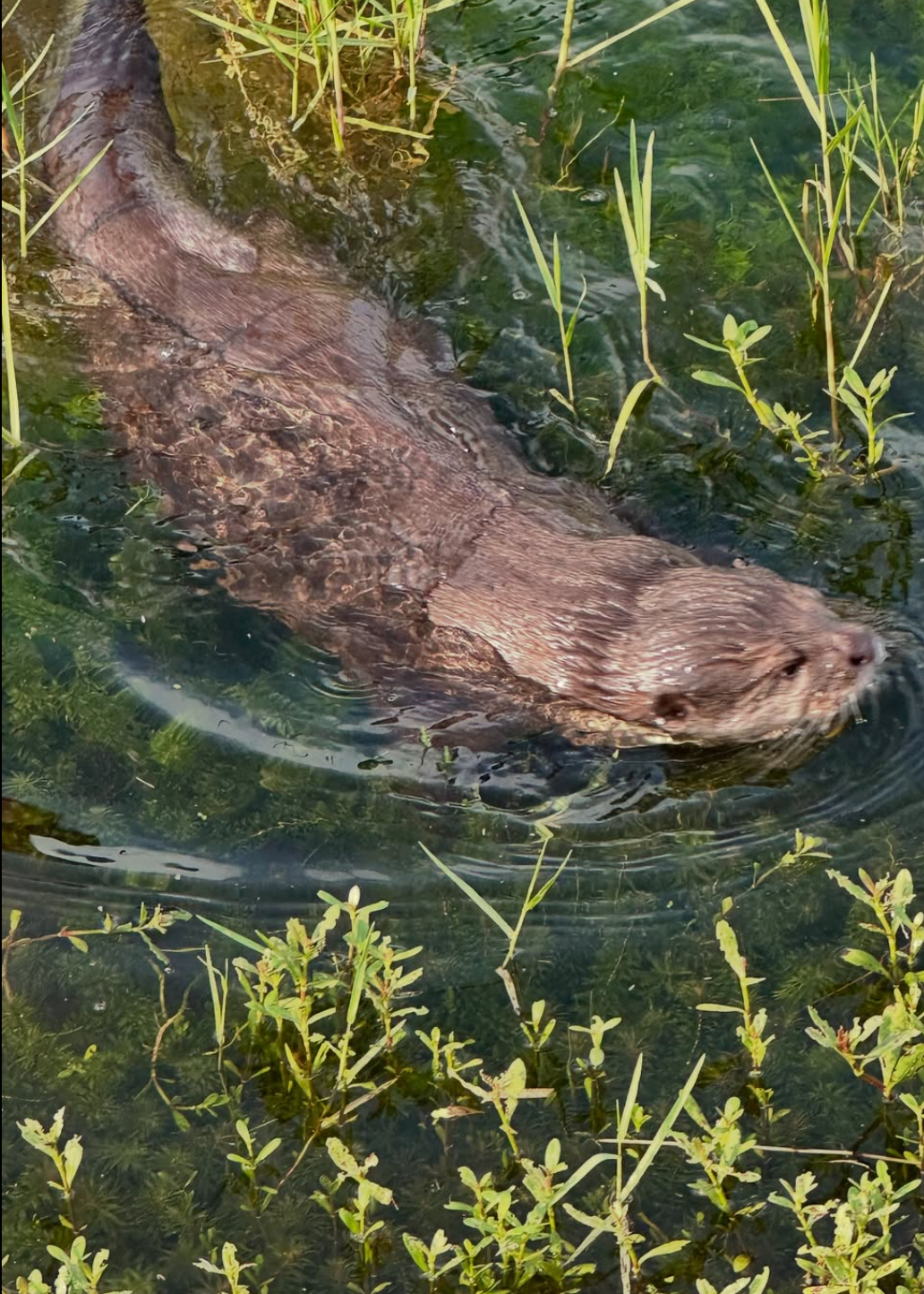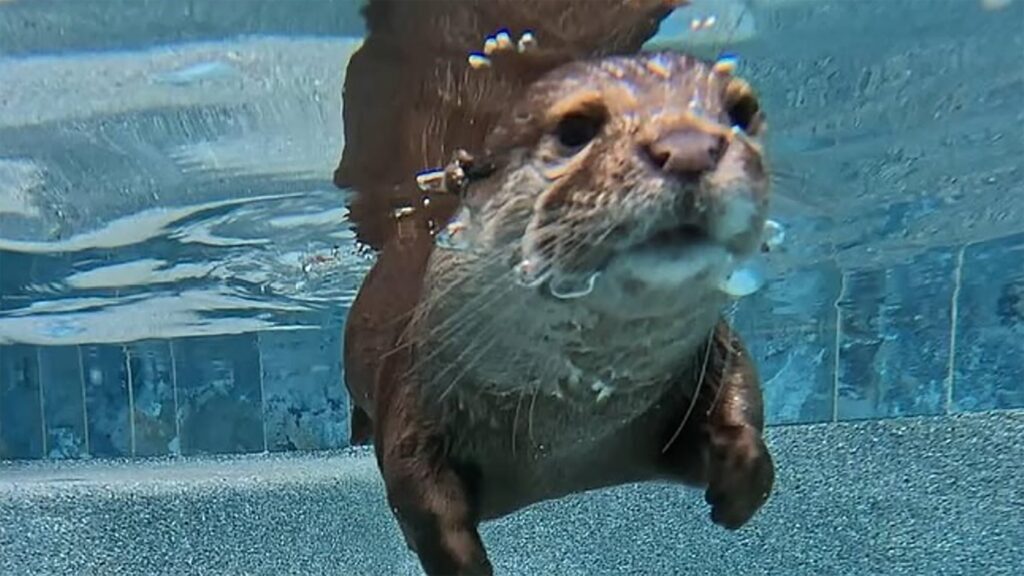Published November 11, 2025 06:22AM
Splash the otter was bored.
So, he did what any intelligent mammal with dexterous paws would do. He pushed his plastic sleeping crate across the room and up against the door. Splash then hopped onto the cage, grabbed ahold of the doorknob, and with a human-like coordination, opened it.
“He went outside to play with the dogs,” Michael Hadsel, Splash’s owner, told Outside. “I was like, you little snot!”
Hadsel, 66, watched this ordeal unfold recently on the camera that he uses to monitor his Peace River, Florida, residence. Hadsel, a veteran of search and rescue teams and recovery diving outfits, operates a company called Peace River K9 Search and Rescue. He trains dogs at his home for SAR squads, law enforcement, and recovery teams—something he’s done for the last 46 years.
In recent years, however, Hadsel has taken on a new breed to teach: Asian small-clawed otters. The aquatic mammals, Hadsel says, are so intelligent and have such strong sensory organs that they can be taught to recover human remains. They are better than trained dogs at sniffing out bodies that are located in oceans or lakes—areas where people often disappear and are never found.
And Hadsel’s newest otter, named Splash, has become the world’s first otter to be trained to recover human bodies.
Splash has also become a furry celebrity on the Internet.
A Hunch Turns into an Experiment
German shepherds, bloodhounds, and other canine breeds have intensely sensitive noses, and they can be trained to find people on mountaintops and even buried in snow. But water hampers even the most adept dog. Bodies quickly decompose at the bottom of the ocean or in a swamp, leaving few traces behind.
“Criminals know this,” Hadsel says. “They know they can throw a body in water and they will win.”
Hadsel has worked as a forensic diver since 2016, and said law enforcement was often stymied when a crime scene was in the ocean. Divers must search a large swath of the sea floor looking for bone fragments or bits of clothing. Sometimes, fish and undersea creatures can devour a body in a few days. Often, these searches prove fruitless.
“I’d be on the bottom trying to find bones, and I couldn’t see the hand in front of my mask,” he said. “It was ridiculous.”
In 2018, while stuck on a plane, Hadsel read an article in an in-flight magazine about trained otters. In Bangladesh and India, fishermen teach river otters how to chase prey into fishing nets. In the Ganges delta, villagers train river otters and keep them on leashes to hunt in the mangrove for fish and shellfish.
One of the species’ greatest attributes is its ability to detect odors underwater, the story said.

At the time, Hadsel was attempting to train horses to sniff out dead bodies. But he saw the river otters as a more versatile animal. In 2019 he contacted a local aquarium and did a preliminary test with an otter.
Then, during the pandemic, Hadsel did more trainings with two river otters he purchased through an exotic pet agency. He named them Hondo and Squeaker.
“They could work odor problems underwater,” he said. “Bingo, we can work with this.”
In early 2024, he received a four-month-old otter through a donation from a zoo in Arizona. He named the otter Splash.
“He still had some wild animal behavior,” Hadsel said. “The biggest problem was teaching him not to bite people. If an otter is mad at you, he will bite you. If he wants to play, he’ll also bite you.”
How Splash Became a Recovery Otter
Otters can be trained through positive reinforcement, and a surprising tonnage of Internet writing and YouTube videos exist online for how to train them. In one clip, filmed at the Seneca Park Zoo in Indiana, a trainer uses hand gestures and a clicker to get an otter to wave, bop its nose onto her hand, and retrieve toys.
Hadsel follows similar techniques to teach Splash in his home swimming pool. He hides an object in the pool that’s been marked with the odor of human remains, and then places the same smell on a ball on the end of a stick. When he says the word “Hoffa”—yes, it’s a reference to the famed Teamsters president who disappeared in 1971—Splash will sniff the ball and dive into the pool and seek out the play cadaver.
Otters smell underwater by blowing bubbles at a target and then quickly breathing them back in. Some of those bubbles will absorb odors, and the otters will detect them. If Splash detects the scent in the pool, he points out the location to Hadsel.
“He’ll bump the ball with his nose or grab my mask, and I give him a piece of salmon,” Hadsel says. “It has to be farm-raised salmon. He won’t eat wild salmon.”
After four months of training, Hadsel and Splash made their debut at a recovery site in Alabama. Splash helped recover a weapon used in a 25-year murder case. They have since been called on for 20 other recovery missions.

“We’ve seen a lot of innovative things with technology AI, but we’re going back to the basics of using an animal to do what they do best,” Sheriff John Budensiek of the Martin County Sheriff’s office told CBS News.
Hadsel has also learned through trial and error how to make Splash more effective. During one mission, Splash was unresponsive to his verbal cues to find “Hoffa.” Otters have a membrane that covers their ears when they swim. So Hadsel tied a string to Splash and trained him to respond to a specific number of tugs.
“One tug is turn right, two tugs is turn left, and three tugs is come back to the boat,” Hadsel said.
Splash Becomes an Internet Celebrity
In May, local TV channel 10 Tampa Bay produced a segment on Splash. The five-minute hit followed Splash through his training and framed the otter as a potential solution for years-old cold cases.
The story was picked up and aggregated by multiple international outlets. Within days, the Peace River K9 Search and Rescue Facebook page had hundreds of new followers, and Hadsel’s email inbox filled up with media inquiries.
More local news stations profiled Splash, and more videos of Splash swimming through Hadsel’s clear pool water, snacking on salmon, and playing with the family dogs and cats, appeared online.
“All of a sudden everyone on the planet wanted to know about this otter,” Hadsel said. “He became a celebrity.”
Hadsel received invites to law enforcement conferences to show Splash. At one, he said, he was approached by officers from Ukraine who wanted to snap a photo with the otter.
There are still hurdles that Hadsel and Splash face—in Florida, they must be careful of alligators, sharks, and other predators.
Splash has also had successes. Of the 20 missions Splash has worked, he has helped find four bodies, Hadsel said. Whether or not this success rate inspires more SAR teams to train otters is yet to be seen. But Hadsel is confident that Splash will get better and finding bodies after more practice.
After all, he’s already gleaned a few new tricks. Splash recently learned how to unscrew the plastic cap on Hadsel’s Coca-Cola bottles so that he could sneak a drink of sugary soda.
“Otters are pranksters,” he said. “They are scary smart.”


